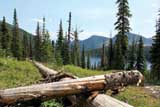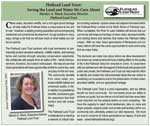Agriculture
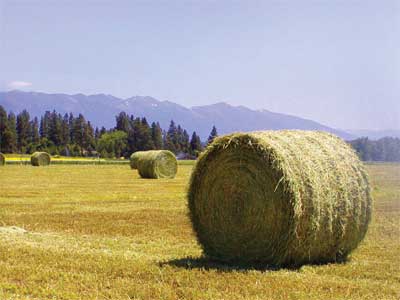 |
| Figure 5.8: Flathead agricultural land. Source: Lori Curtis |
Agriculture is part of the historic culture in the Flathead Watershed and continues contributing to its economic diversity. Unfortunately some agricultural practices can also result in a significant source of pollution. Many things can be done to reduce agriculture’s potentially negative impacts on the watershed.
Develop an Agriculture Plan
Planning makes your land more productive and saves money over the long term. It can also improve property value, increase productivity, grow healthier livestock, ensure better water quality, and satisfy our stewardship responsibility.
Getting to Know Your Land
Knowing what type of soil is on your property will help you understand how much your land will produce, how water moves through the soil, how much irrigation and fertilizer is required, and whether the area is a functional wetland.
| Controlling Weeds There are a number of ways to keep weeds under control including buying weed-free hay, planting only certified seed, washing your vehicles after being in a weed-infested area, monitoring weeds, and responding quickly to new infestations. Biological controls such as certain fungi and insects can help weaken weeds by attacking seed heads and other plant parts. Small weed patches and weeds near streams should be hand pulled, and large patches should be mowed before they go to seed. Livestock can be used to effectively graze weeds before they go to seed, but care should be used to avoid moving livestock from a weedy area to a weed-free area as they can spread weed seed through their feces and from their coats. When used according to guidelines for appropriate quantities and at the right time of year, herbicides can be very effective. |
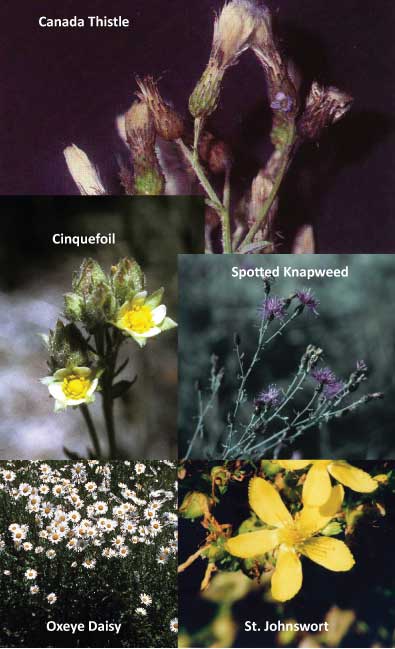 |
||||
|
Irrigation
Irrigation is typically required when soil moisture drops to about 50 % of its water-holding capacity in the top 3 feet (1 m) of soil. There are numerous ways to irrigate, including sprinkler, flood, and “big gun” methods.
- Sprinkler irrigation encompasses moveable hand lines, wheel lines, and central pivot. They use the least amount of water, but require some labor to move the pipe, ongoing maintenance, and an initial investment. Also, the “saved” water is often used to irrigate more acres with less return flow.
- Flood irrigation requires much water, fails to spread water evenly across a pasture, and requires labor, but is low maintenance, and the least expensive when irrigation ditches are in place. Flood irrigation also produces a greater return flow.
- Big gun sprinklers tend to apply excess water and incur high power costs. Water distribution is fair, cost is moderate, and minimum labor and maintenance are required. It is not very effective on clay-type soils.
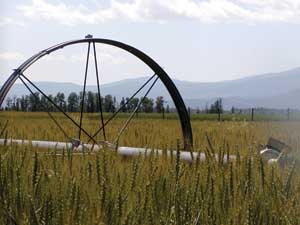 |
| Figure 5.10: Farmland irrigation. Source: Lori Curtis |
Livestock Management
To achieve successful grazing:
- Eliminate continuous season-long grazing.
- Subdivide large pastures into smaller pastures and develop pasture rotation systems.
Corral livestock and feed them hay until pasture grasses are 6” to 8” (15 to 20 cm) high. Move livestock when 3” to 4” (7.6 to 10 cm) of grass height remains.
Corral animals or continue rotation during winter months to distribute manure and feed wastes evenly across your pastures. - Allow long rest periods or use high-intensity, short-duration grazing system to rejuvenate poor condition pasture.
- Provide a water source for each pasture.
- Irrigate (if you have irrigation) each pasture immediately after grazing to encourage plant growth, and don’t graze on wet soil in order to avoid soil compaction.
- Remember, horses only need a few hours of grazing on good pasture each day. Corral animals at the end of the day to prevent overgrazing and extend the availability of forage in your pastures.
- Use fencing appropriate to your activities.
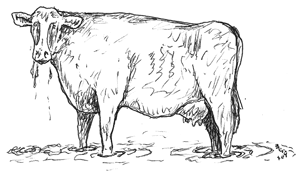 |
| Figure 5.11: Dairy cow. Source: Todd Berget |
Livestock can damage riparian areas by trampling or grazing streamside and lakeside vegetation, and eroding stream banks and lake shores. If livestock must be grazed in riparian areas:
- Set grazing and resting periods alternating the season and limiting the duration of grazing in each area.
Maintain plant growth to filter sediments and prevent bank erosion and undercutting. - Rest riparian pastures during the critical growth period of plants—this is essential to stream bank and lake shore stability.
- Install and maintain fences to keep livestock restricted from the water (“water gap”) thereby protecting waterside vegetation.
- Provide off-site water locations where adequate forage is available.
- Lure livestock away from water sources by placing salt blocks and feed at a distance or upland from the water.
- Store manure in properly designed locations as far away as possible from waterways to reduce nutrient-rich contaminated runoff.
- Compost manure to reduce volume, kill parasites and weed seeds, reduce odor, and develop fertilizer.
- Consider a hardened site with fencing to strictly limit livestock in the riparian area.
“To waste, to destroy our natural resources, to skin and exhaust the land instead of using it so as to increase its usefulness, will result in undermining in the days of our children the very prosperity which we ought by right to hand down to them amplified and developed.”
- Theodore Roosevelt (1858 – 1919), 26th U.S. President, Seventh Annual Message, December 3, 1907.
Farming
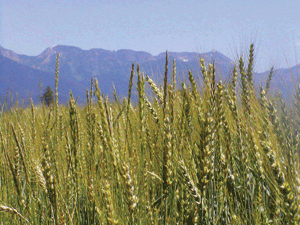 |
| Figure 5.12: Flathead farmland. Source: Lori Curtis |
Farming requires knowledge of the landscape and a huge commitment to the land. Invaluable experience is often passed through generations of hard-working farming families. There are also many important contributions to this knowledge base from current agricultural research. County extension programs are available to help small farm owners minimize losses and increase profits, and to help protect our food supply and sustain natural resources for the future.
Some important tips for farming include:
- Minimize the use of chemical pesticides and herbicides, and use the least toxic products available.
- Don’t spray chemical insecticides or herbicides in or near wetland or riparian areas, during wind speeds of greater than five miles per hour, or when rain is in the forecast.
- Apply only the amount of fertilizer needed and only during the growing season when it is actively used by plants.
- Leave or develop at least a 100 foot buffer strip of vegetation along stream banks and lake shores.
Prevent erosion by contour-plowing and strip-cropping. - Plant winter cover crops to stabilize soil and reduce erosion.
- Control noxious weeds through biological control, mowing, hand pulling, or limited herbicide spraying
.
Consider a Conservation Easement
A conservation easement is a voluntary legal agreement between a land owner and an easement holder that establishes the land owner’s commitment for retaining all of a portion of their property as open lands, and specifying what future uses will and will not be allowed on the property. An easement is attached to the deed of a property forever. The easement holder is responsible for ensuring the terms of the easement are met in the future. With a conservation easement, the land owner continues to own and manage the property and can still produce crops, hay, livestock, timber and other commodities as determined in the agreement.
There are a number of reasons landowners place easements on their properties. Some landowners simply want to protect private lands in perpetuity because of their deep bond with the land. In this way, they can ensure the property will remain whole and intact long after they are gone. The value of the easement may qualify as a charitable contribution and potentially be eligible for federal income tax and estate tax benefits. Although easements restrict the commercial, industrial, and/or residential subdivision development of the property, the value of the land is not necessarily diminished.
Interestingly, due to their relative scarcity, large parcels are attractive to certain buyers and under the right circumstances can be sold at a premium. However, in a practical sense the value of the land is diminished—voluntarily for conservation purposes—and the landowner can potentially receive tax benefits. Conservation easements are therefore helpful in estate planning where land is a major asset of family holdings, as they can substantially reduce the value of the land for tax purposes.
| Resources for Conservation Easements |
| Flathead Conservation District 406.752.4220 http://www.flatheadcd.org |
| Lake County Conservation District 406.676.2842 http://www.lakecounty-mt.org |
| Montana Department of Agriculture http://agr.mt.gov 406.444.3144 |
| Montana Department of Natural Resources and Conservation 406.444.6667 Best Management Practices for Grazing Tips on Land & Water Management for Small Farms & Ranches in Montana |
| Montana Land Reliance http://www.mtlandreliance.org 406.443.7027 |
| MSU Flathead County Extension http://flathead.mt.gov/extension 406.758.5553 |
| MSU Lake County Extension http://www.msuextension.org/lake 406.676.4271 |
| The Flathead Land Trust http://www.flatheadlandtrust.org 406.752.8293 |
| The Nature Conservancy http://www.nature.org/wherewework/northamerica/states/montana/ 406.443.8311 |

